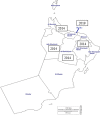A comparative study of single Theileria lestoquardi and mixed infections with Theileria ovis
- PMID: 34284816
- PMCID: PMC8290529
- DOI: 10.1186/s13071-021-04864-6
A comparative study of single Theileria lestoquardi and mixed infections with Theileria ovis
Abstract
Background: Epidemiological surveys in Oman have revealed a high prevalence of the co-occurrence of the pathogenic Theileria lestoquardi and the non-pathogenic Theileria ovis among sheep in the Barka region, Oman. Our most recent data illustrated an interaction and reduced mortality risk in animals co-infected with T. lestoquardi and T. ovis, suggesting that the latter confers protection against pathogenicity of T. lestoquardi. The present study extends the above findings and examines disease outcomes; clinical markers, hematological parameters, and parasite density in mixed and single T. lestoquardi infections.
Methods: A total of 390 blood samples were collected from 16 sheep pens located in Barka, Oman between July and November 2019. Theileria spp. were detected and quantified using qPCR assay targeting 18S rRNA, and the extent of genetic diversity was estimated by a panel of T. lestoquardi specific micro- and mini-satellites. The association of some disease markers with the presence of Theileria spp. and genetic diversity was tested.
Results: Theileria spp. were detected in 75 (19.2%) sheep; of these 65 (86.7%) had mixed infections (T. lestoquardi plus T. ovis), 8 (10.6%) were infected with T. lestoquardi alone, and 2 (2.7%) with only T. ovis. Exotic breeds had a higher risk for Theileria spp. infection. The density (18S rRNA gene copies) of both parasites was higher in single infection against mixed infection, and there was a relatively lower density of T. lestoquardi in mixed infections. However, there was no difference in hematological indices between single T. lestoquardi and mixed infections. High genetic diversity was observed among T. lestoquardi in Barka, with no differences of T. lestoquardi in single and mixed infections. The extent of diversity seen in Barka was higher (He = 0.772) than that reported in Oman in 2019 (He = 0.582), with distinct T. lestoquardi genotypes.
Conclusion: The lower density of T. lestoquardi as mixed infection with T. ovis compared to single infection supports the hypothesis that T. ovis confers protection against lethal T. lestoquardi infection. However, there were no differences in disease correlations (clinical markers, hematological parameters, and density of parasites) or the extent of diversity of T. lestoquardi between the two types of infection. The presence of distinct T. lestoquardi genotypes in Barka, compared to that reported earlier in Oman, likely reflects movement of carrier animals and highlights the need for further analysis of the parasite populations to inform novel approaches for controlling malignant ovine theileriosis.
Keywords: Genetic diversity; T. ovis; Theileria lestoquardi; Theileriosis.
© 2021. The Author(s).
Conflict of interest statement
The authors declare that they have no competing interests with regard to this publication.
Figures


Similar articles
-
Molecular surveillance of Theileria parasites of livestock in Oman.Ticks Tick Borne Dis. 2017 Aug;8(5):741-748. doi: 10.1016/j.ttbdis.2017.05.008. Epub 2017 May 21. Ticks Tick Borne Dis. 2017. PMID: 28558992
-
Molecular Epidemiology and Phylogeny of Theileria ovis and Theileria lestoquardi in Sheep and Goats from Southern Punjab, Pakistan.Vector Borne Zoonotic Dis. 2024 Oct;24(10):656-665. doi: 10.1089/vbz.2023.0118. Epub 2024 May 14. Vector Borne Zoonotic Dis. 2024. PMID: 38743635
-
Theileria lestoquardi in Sudan is highly diverse and genetically distinct from that in Oman.Infect Genet Evol. 2018 Aug;62:46-52. doi: 10.1016/j.meegid.2018.04.014. Epub 2018 Apr 13. Infect Genet Evol. 2018. PMID: 29660557
-
Dynamics and within-host interaction of Theileria lestoquardi and T. ovis among naive sheep in Oman.Sci Rep. 2020 Nov 13;10(1):19802. doi: 10.1038/s41598-020-76844-2. Sci Rep. 2020. PMID: 33188233 Free PMC article.
-
Ovine theileriosis in China: a new look at an old story.Parasitol Res. 2007 Sep;101 Suppl 2:S191-5. doi: 10.1007/s00436-007-0689-2. Parasitol Res. 2007. PMID: 17823827 Review.
Cited by
-
Molecular detection and characterization of Anaplasma ovis, Theileria ovis, and Theileria lestoquardi in sheep and goats in Luxor, Egypt.BMC Vet Res. 2024 Jun 17;20(1):260. doi: 10.1186/s12917-024-04109-5. BMC Vet Res. 2024. PMID: 38886742 Free PMC article.
-
Seasonality, epidemiology and phylogeny of Theileria ovis with a note on hematological and biochemical changes in asymptomatic infected goats from Pakistan.PLoS One. 2023 Aug 29;18(8):e0290620. doi: 10.1371/journal.pone.0290620. eCollection 2023. PLoS One. 2023. PMID: 37643200 Free PMC article.
-
Anaemia in Sheep Caused by Babesia and Theileria Haemoparasites.Animals (Basel). 2022 Nov 29;12(23):3341. doi: 10.3390/ani12233341. Animals (Basel). 2022. PMID: 36496866 Free PMC article. Review.
-
Quantification of Acute and Chronic Theileriosis in Sheep by Quantitative PCR (qPCR).Arch Razi Inst. 2023 Feb 28;78(1):389-396. doi: 10.22092/ARI.2022.359033.2358. eCollection 2023 Feb. Arch Razi Inst. 2023. PMID: 37312733 Free PMC article.
-
Molecular detection of Theileria spp. in native sheep and estimation of hemato-biochemical parameters from Sulaimani province/Iraq.Front Vet Sci. 2022 Dec 16;9:1059599. doi: 10.3389/fvets.2022.1059599. eCollection 2022. Front Vet Sci. 2022. PMID: 36590791 Free PMC article.
References
-
- Altay K, Dumanli N, Aktas M. A study on ovine tick-borne hemoprotozoan parasites (Theileria and Babesia) in the East Black Sea Region of Turkey. Parasitol Res. 2012;111(1):149–153. - PubMed
-
- Panel. Ahaw Scientific opinion on geographic distribution of tick-borne infections and their vectors in Europe and the other regions of the Mediterranean Basin. EFSA J. 2010;2010(8):1723.
-
- Yin H, Schnittger L, Luo J, Seitzer U, Ahmed JS. Ovine theileriosis in China: a new look at an old story. Parasitol Res. 2007;101(2):191–195. - PubMed
-
- Tageldin MH, Fadiya AAK, Sabra AAY, Ismaily SIAI. Theileriosis in sheep and goats in the Sultanate of Oman. Trop Anim Health Prod. 2005;37(6):491–493. - PubMed
-
- Al-Fahdi A, Alqamashoui B, Al-Hamidhi S, Kose O, Tageldin MH, Bobade P, et al. Molecular surveillance of Theileria parasites of livestock in Oman. Ticks Tick-borne Dis. 2017;8(5):741–748. - PubMed
Publication types
MeSH terms
Substances
Grants and funding
LinkOut - more resources
Full Text Sources
Miscellaneous

